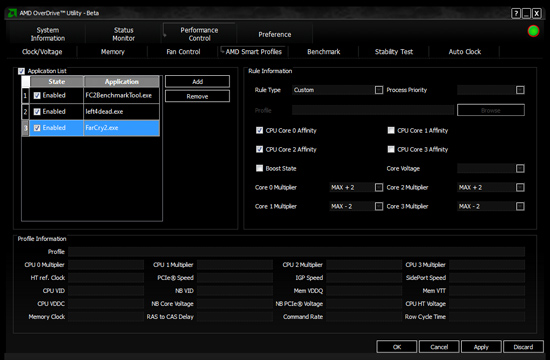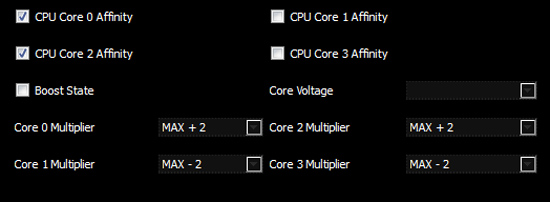AMD's Phenom II X4 955 Black Edition
by Anand Lal Shimpi on April 23, 2009 12:00 AM EST- Posted in
- CPUs
The Software Answer to Intel’s Turbo Mode
The Core i7 has its Turbo Mode. When only one core is active, power is shut off to all other cores and the active one can run at higher clock speeds. Even when all four cores are active, as long as the processor isn’t running too hot, the entire chip can run at a higher frequency. The default turbo speeds for the three i7s out on the market are listed below:
| Processor | Stock Clock Speed | Max Turbo (All Four Cores Active) | Max Turbo (One Core Active) |
| Intel Core i7-965 | 3.20GHz | 3.33GHz | 3.46GHz |
| Intel Core i7-940 | 2.93GHz | 3.06GHz | 3.20GHz |
| Intel Core i7-920 | 2.66GHz | 2.80GHz | 2.93GHz |
Turbo mode is an interesting concept because it allows end users to experience higher performance without ever having to even know about overclocking. In its first incarnation on Nehalem, Intel was quite conservative with how far they pushed Turbo. Given that our Core i7 920 had no problems running at up to 3.8GHz without increasing its core voltage, I’d say that Intel could stand to be a bit more aggressive with its turbo modes.
Note that in all of our multithreaded tests, the Core i7 has no problems running at its “turbo” frequency. In other words, the i7-920 runs at 2.80GHz far more frequently than it runs at 2.66GHz.
AMD unfortunately does not have a similar capability in its processors. Intel dedicated around 1M transistors to an on-die microcontroller called the PCU (Power Control Unit). The Core i7’s PCU tracks power consumption and manages clock speeds and voltages to ensure that the i7 always delivers the best performance when you need it, and the lowest power consumption when you don’t.
AMD didn’t go in and introduce any major architectural changes in the Phenom II X4 955 and most likely won't for a while. Instead, AMD is hoping to deliver a turbo-like feature in software.
The software is AMD’s Overdrive Utility 3.0 and the feature is called AMD Smart Profiles.

It works like this: you select an executable, and then using AOD3 you can set what cores that executable should run on and what clock speeds those cores should run at. AMD will have predefined profiles for various games but you can also create your own profiles.

Since the majority of desktop applications aren’t multithreaded, you’d stand to benefit from running two of your cores at a higher frequency and dropping the clock speed on the remaining two cores. That way you could keep power consumption unchanged, while improving performance.
It does work, I ran a quick test on Left 4 Dead and Far Cry 2:
| Processor | Left 4 Dead | Far Cry 2 |
| Smart Profiles Enabled | 124.1 fps | 53.3 fps |
| Smart Profiles Disabled | 121.4 fps | 51.2 fps |
| Performance Improvement | 2.2% | 4.1% |
In these cases the games were forced to run on two cores specifically (at least the .exe files) and those two cores were overclocked by 400MHz, while the remaining two cores were underclocked by 400MHz. The end result was that performance improved by 2% in Left 4 Dead and 4% in Far Cry 2.
There’s obviously more flexibility with AMD’s method than Intel’s and you could potentially get a much greater performance improvement. There are a couple of downsides. For starters, there’s no guarantee of stability but if you keep the overclocks mild and/or accompany them with a corresponding increase in core voltage then you can minimize that risk. The other obvious downside is that for the majority of applications and games you’ll have to create profiles manually. Honestly I’d prefer if the CPU did the work for me, but if you enjoy customizing your system then you’ll feel right at home with AOD3’s Smart Profiles.
AMD will add new profiles as time goes on. AMD does have plans for a turbo mode in future microprocessors, but we won’t see them until 2011.










65 Comments
View All Comments
Procurion - Thursday, April 23, 2009 - link
Cool. My next question would be to wonder why it didn't kick in for the other tests? I guess it wasn't enabled for them? Looks good overall.JarredWalton - Thursday, April 23, 2009 - link
See page 4 - Turbo mode tends to activate pretty much any time a load is on the CPU. But it's not really "unfair" as all i7 users get that benefit without doing anything extra, plus i7 chips still overclock far beyond that point.ChemicalAffinity - Thursday, April 23, 2009 - link
Best post ever.whatthehey - Thursday, April 23, 2009 - link
Congratulations on the cryptic post... or is that pointless post? I'm guessing you're suggesting that the words listed were used with two different companies - AMD and Intel - but if so they certainly weren't used in this article in any way I can see. Care to enlighten the rest of us on the point of your comment?Some people are too clever for their own good; others merely think they're clever. Guess which one you are.
Lokinhow - Thursday, April 23, 2009 - link
Oh man, I thinking about the OC3.9GHz on Vista x64
4.2GHz on Vista x86
Why it happens?
Does the results are the same using XP x86/x64 and Windows 7 x86/x64?
That would be interesting to see if it is possible to reach 4.2GHz on Windows 7 x64
Griswold - Thursday, April 23, 2009 - link
Dont hold your breath. Theres more registers (etc) in use under a 64bit OS than a 32bit one. Its highly unlikely that there will be any difference on the exact same hardware. And even if there is a difference between xp/vista/7, 32bit 7 will outdo 64bit 7 as well. 64bit was never the ideal choice for overclocking records...Spoelie - Thursday, April 23, 2009 - link
In the CS4 test, given the large increase in performance when just going from DDR2 to DDR3, would a faster NB clock (2->2.6/2.8ghz) and faster than DDR1333 memory, while keeping the core at default clock, level the playing field with the core2 processors?Seems that in this particular test the phenom is starved for data.
duploxxx - Thursday, April 23, 2009 - link
why do you use these 1GB dimm's in ddr3 config? I would assume you have more oc issues with 4 dimms in stead off 2 dimms?G.Skill DDR2-800 2 x 2GB (4-4-4-12)
G.Skill DDR2-1066 2 x 2GB (5-5-5-15)
Qimonda DDR3-1066 4 x 1GB (7-7-7-20)
Corsair DDR3-1333 4 x 1GB (7-7-7-20)
Holly - Thursday, April 23, 2009 - link
Nice article :-)btw... last paragraph on the first page... "faster than the Core 2 Duo Q9550." should say "faster than the Core 2 Quad Q9550."
ibm386 - Sunday, June 27, 2010 - link
Intel and Amd are owned by the same person. Since a person can't have monoply in U.S. It has been divided into two different names and obviously diff. CEOs.cheers.